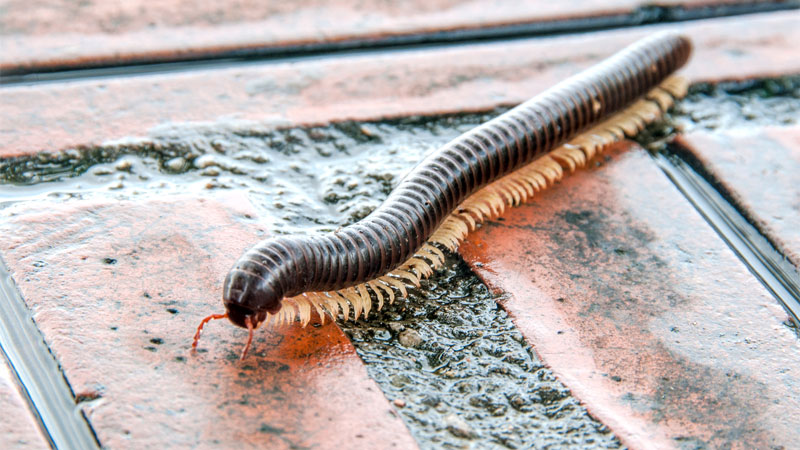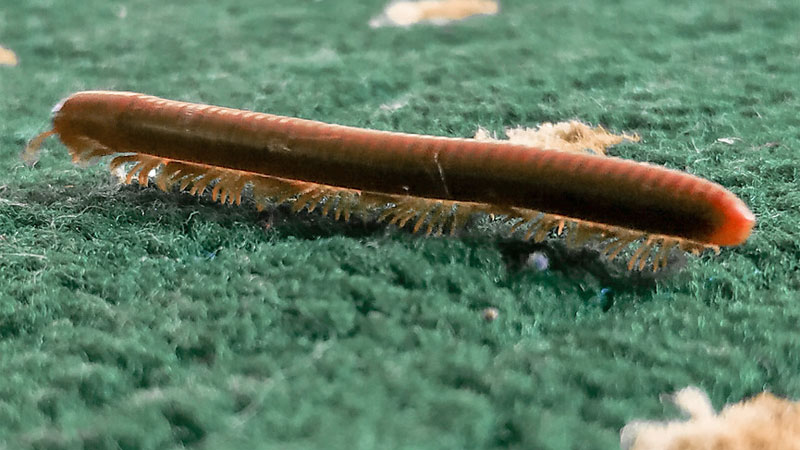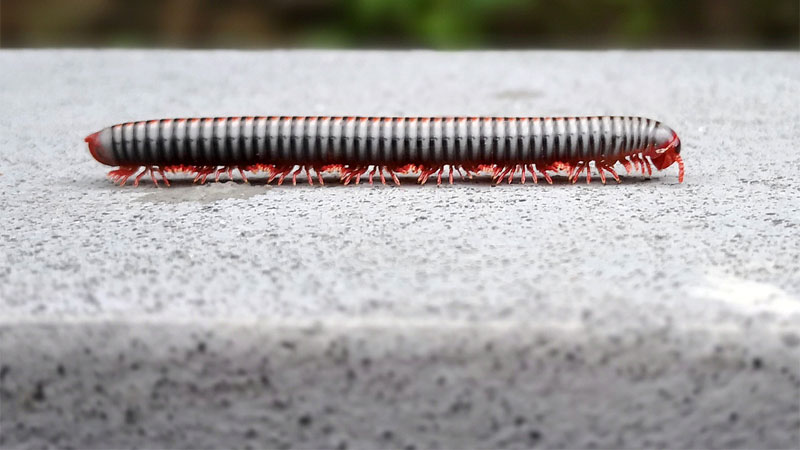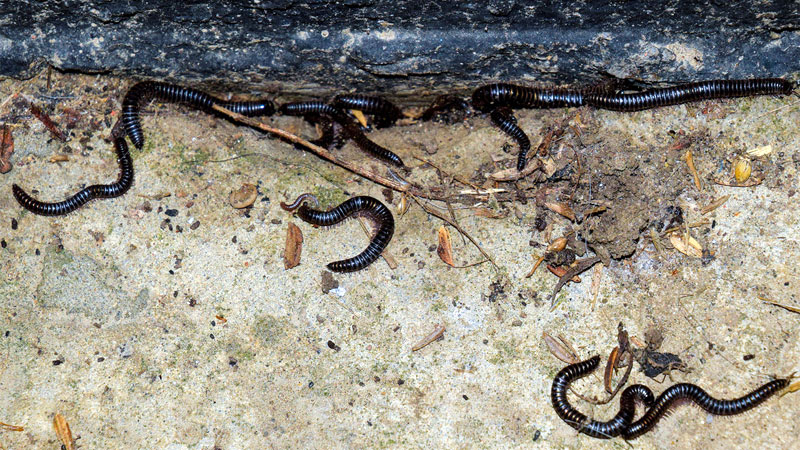Few pests create a sense of pure disgust as millipedes. Known for having multiple legs per body segment, these critters seem to have crawled right out of your worst nightmares and into your home.
But are these tiny terrors really so evil? Why are they hanging out in your home? And what can you do to get rid of millipedes? Today, we’re seeking to answer all of those questions and more.
Getting Rid of Millipedes
Getting rid of these pests isn’t as difficult as you might at first think. Of course, the sheer numbers in a full-blown millipede infestation can catch a lot of people off-guard. This is especially true if your property has been a popular site for breeding, since these critters tend to stay concealed.
That said, let’s start off by looking at ways to track down the millipedes, then discuss elimination tactics, and finally ways to prevent them from coming back.
Locating Millipede Nesting Grounds
The first thing you need to do is locate the spot the millipedes are congregating or hiding. We’ll start off with the home, then move our search outdoors.
In the Home
Begin with the areas that normally have excess moisture or higher humidity. These include common pest locations such as the kitchen, bathroom, other first floor rooms, the basement, and the garage. This latter may or may not be attached to the house, so we’re including it here for simplicity’s sake.
Carefully shift any boxes or clutter to check below and behind. This is also a good excuse to clean and get organized, by the way, as clutter is often an open invite for a wide range of pests.
Take note when you spot a millipede or two, and if you see a whole bunch of them together, you’ve likely found a nest. The nests will be your primary concern.
In the Yard
Most yards are chock full of places for these nuisance pests to hide, so again, this is a good time to clean up. Check under rocks and wood piles, loose bricks or flagstones, and in leaf piles or compost.
Mulch is also a popular location, as the bark or other materials keep the soil surface moist. Again, make a note of where you see individual millipedes, but the main goal is to find their nests.
Kill Tactics
Millipedes can be highly beneficial to the environment, but that doesn’t mean you want to keep them around (unless you have one as a pet, that is), so kill methods are often the way to go.
Here are some chemical and home remedies that have proven themselves reliable. Remember, individual mileage can still vary, so consider using two or more techniques for more efficient millipede control.
Do you remember we mentioned those defensive secretions? When you crush one, these secretions are part of the splatter and will also leave the spot smelling positively foul.
#1 – Diatomaceous Earth
You’ve heard the phrase “fight fire with fire”, so why not fight a fossil with fossils? Diatomaceous earth (DE for short) is a great solution when you want something safe and effective. The product is actually the crushed, fossilized shells of microscopic diatoms.
When using food-grade DE, it looks and feels like dust to us, but for a bug, it’s like walking on broken glass. The sharp edges lacerate the exoskeleton, cutting through the waxy coating that holds moisture in, causing the bug to die of dehydration.
The only downside is that you may have to reapply every few days, especially outdoors, and it’s ineffective if it gets wet.
#2 – Use Insecticides
There are a number of insecticides out there that will work on millipedes. Some are sprays while other are dusts or even granular insecticides, and each one will have its own set of instructions. Here are a three products that do well against these critters:
When purchasing one of these pesticides, first check to be sure the product is formulated to work on millipedes. Always follow usage instructions carefully, and try to focus on nesting sites.
Remember, chemical pesticides can be highly toxic, so wear gloves and a mask when using and keep kids and pets away during treatment. When possible, look for a product that doesn’t leave behind residue for extra safety.
#3 – Boric Acid
This common household chemical is quite useful in pest control, but you need to be careful when using it. Simply sprinkle boric acid along edges or in nesting areas where you’ve seen millipede activity.
The acid wears away the waxy coating over the millipede’s exoskeleton, causing it to slowly dehydrate. In addition, if the millipede eats the acid, it will destroy its digestive system.
While great for making bait traps, using boric acid as an insecticidal powder is risky because it’s toxic to both humans and pet. Thus, it’s preferable in this case to use diatomaceous earth.
#4 – DIY Millipede Trap
You can build a trap very similar to the one you use for fruit flies to kill millipedes.
- Just take a soda bottle and cut the top off where it begins to get smaller.
- Drop a piece of fruit in the bottom and tape or glue the top back on inverted.
- Now get a piece of tubing big enough for the millipede to fit into and slip it into the mouth of the bottle so no more than two inches is inside.
The millipede will crawl through the little tunnel when it smells the fruit rotting and drop down inside where it will become trapped and soon die.
#5 – Send Them Swimming
You probably have no desire to go grabbing millipedes with your bare hands or even wearing gloves, but you can still get them with a broom and dustpan.
Catch the little buggers and dump them straight into a bucket of soapy water where they’ll drown in moments.
#6 – Suck Them Up
You can use your vacuum cleaner to simply suck the little critters up into the bag or canister and dispose of them.
#7 – Use a Perimeter Defense Spray
One of the best ways to keep pests from getting in and kill those that try is a perimeter defense sprays such as Ortho Home Defense.
These pesticides are sprayed around the base of your foundation, where they create a toxic barrier that can last several months. We point out Ortho specifically because this particular product won’t stain and is safer around pets and kids once it’s been applied.
#8 – Call for Backup
Chances are, you won’t need to pay the cost for a pest control company to come take care of these pests. However, we know there are times when a little help is needed.
This is especially true if something happened to cause multiple infestations (such as a damaged foundation) or you don’t have the time to rely on slower DIY methods. In such cases, don’t be afraid to hire some professional help.
How to Keep Millipedes Away
Millipedes are attracted by many of the same things as other pests, meaning you can ward off a wide range of potential home invaders at the same time.
Keep it Dry
While millipedes are naturally attracted to sources of water, they often end up invading homes because of heavy rains or drought conditions. Once they get inside, they’ll try to set up shop where there’s moisture so they can look for fungus or other food sources.
This means they can show up most often in kitchens, bathrooms, and basements. However, your home’s humidity is high enough they can appear almost anywhere.
Try to clean up any spills as soon as they occur and fix all leaky pipes. Consider adding a dehumidifier to your basement or other areas where humidity is high but human activity is low. Also, remove any sources of standing water from your yard.
Eliminate Their Shelter
The cleaner your yard is, the harder it is for millipedes to set up shop. Remove all leaf litter promptly, as well as rotting or fallen fruit. In fact, just about any decaying organic matter is an open invite.
Avoid using wood mulch, clean up after mowing the lawn, use sealed compost boxes when making compost, and make sure any firewood piles are kept off of the ground and away from the house.
Indoors, you’ll want to avoid leaving food waste laying about and scoop any litter boxes regularly. Keep the trash sealed, especially if it contains organic matter, and don’t leave clutter on the floor.
Vacuuming, dusting, and other common cleaning chores can go a long way towards making your home inhospitable.
Lock the Door
Finally, examine your home for any potential entry points. Make sure door and window frames are properly caulked, replace broken screens, and seal all cracks or holes in the walls and foundation.
Also use exclusion devices or caulk at pipe entrances, vents, and the like. Remember, millipedes are excellent climbers, so don’t just cover the ground floor and foundation.
While you’re at it, go around the perimeter of your house. Create a strip of bare soil at least six inches from the foundation to create a buffer zone.
Getting to Know Millipedes
While many people think millipedes are insects, they are actually arthropods known scientifically as the class Diplopoda, named for the pairs of jointed legs they have down the length of their bodies. But that’s only the beginning of some very fascinating details about this common pest.
Here’s some more information, some good and some downright creepy.
What Do Millipedes Look Like?
While there’s quite a wide range of shapes and sizes out there (there are over 12,000 known species of millipedes, after all!), the most common ones tend to be cylindrical and somewhat resemble armored worms on an army of legs.
Many species are absolutely tiny, with the shorted being a mere 1/16 inches long. The giant African millipede (Archispirostreptus gigas) is the largest living millipede, but there are fossils of prehistoric millipedes as long as 6 1/2 feet!
And speaking of prehistoric, these guys are living fossils, having originated in the Silurian Period, over 400 million years ago. This is also about the same time the millipedes and centipedes parted ways in evolutionary terms.
Millipedes are commonly broken down into two categories: the shorter “pill millipedes” (often confused with pill bugs) and the longer Helminthomorpha. Depending on the group, their bodies may be cylindrical or more hemispherical, with multiple segments. Most of these segments have two pairs of jointed legs.
How Many Legs Does a Millipede Really Have?
This is where the biology gets fun. Most millipedes actually only have between 34 and 400 legs, and – until recently – the record holder had 750 pairs. However, there are an estimated total of 15,000 to 80,000 species out there and new ones are being discovered all the time.
One of those recently discovered was Eumillipes persephone, an Australian native found in 2020 and described in 2021. While we won’t get into too much detail about this critter, we will say that it’s now the world’s record holder for most legs at an insane 1,306 legs on one of the specimens collected!
What Do Millipedes Eat?
The majority of millipedes out there are detritivores, meaning they help break down feces, decaying organic matter, or even fungus.
However, a few are carnivorous and (more importantly) some species will attack living plants and can pose a significant agricultural risk.
The Bizarre Millipede Lifespan
Bristle millipedes (Order Polyxenida) don’t directly mate. Instead, the males create webs on which they deposit their spermatophores for females to collect.
But if you think that’s weird, all other millipedes have foot sex. The males have modified legs, usually on segment 7, known as gonopods. These special legs deposit sperm. However, the actual genitals of both males and females are under the third segment.
When the male first attempts to mate, the female will often enter a defensive curl. Depending on the species, the male will then calm her by doing one of a number of things, such as providing edible secretions, tapping her back with his antennae, running up and down her back to massage her, or even chirp a soothing song at her.
The female can lay anywhere from 10 to 300 eggs (again, depending on the species), fertilizing them as she goes. Some species lay the eggs on plant materials or moist soil while others create a nest and line it with dried feces, wrapping the eggs in a protective cocoon. A few species even stick around to care for their young.
After a few weeks, the eggs hatch into stubby little critters with six legs (as we mentioned above). In some species, they only become fertile at their final moulting, although some species will alternate between fertile and infertile as they molt.
Depending on the species, a millipede can live from one year to as long as 10 years.
Why Do I Have So Many Millipedes?
Normally, you might not even notice just how many millipedes are living on your property. They tend to live under rocks and other surfaces because the soil doesn’t dry out as fast under there.
Unfortunately, in drought conditions, that soil may also become too dry. Meanwhile, in heavy rains, it might become too saturated. In both cases, millipedes may seek the more balanced environment that is your home.
Another factor in how many millipedes you might run into is the amount of decaying matter on your property. Millipedes are credited with being the primary means of decomposing fallen leaves. They’ll also find your property attractive if you leave grass cuttings out or use wood chips for mulch.
Can Millipedes Hurt You?
For the most part, no. Millipedes are extremely docile and even kept as pets. They won’t bite or sting and of the 12,000 species we’ve discovered, not one has been found to be potentially toxic to humans.
There’s currently no solid evidence that these critters can be disease vectors in the kitchen. In fact, they don’t even like to infest human food!
So where’s the catch?
Millipedes are known for two major defense mechanisms. When threatened, they’ll curl into a tight spiral to protect their fragile undersides. However, if this doesn’t work, they can secrete or spray an acidic toxin.
The toxin contains hydrochloric acid and hydrogen cyanide. Not only can it result in skin irritation, but these secretions are known to be an allergen to some people, and it can be potentially harmful if you get it in your eyes, nose, or mouth.
Millipede vs Centipede

Several millipede species closely resemble centipedes from a distance, but there are actually some key differences – if you’re willing to get close enough to check. Some of the most important ones:
Centipedes have poisonous claws extending from just behind the head, whereas millipedes lack this feature. Millipedes have shorter, segmented antennae, while centipedes have longer antennae that tend to be straighter.
Millipedes are usually darker brown to black, with some species being reddish, and centipedes are often a medium to light brown.
However, the biggest difference is in the legs. Millipedes tend to have two pairs of legs per segment, and centipedes tend to have one pair of legs per segment.
- How to Get Rid of Hawks - March 8, 2024
- How to Get Rid of Pill Bugs (Rolly Pollies) - March 1, 2024
- How to Get Rid of Groundhogs (Woodchucks) - February 5, 2024





